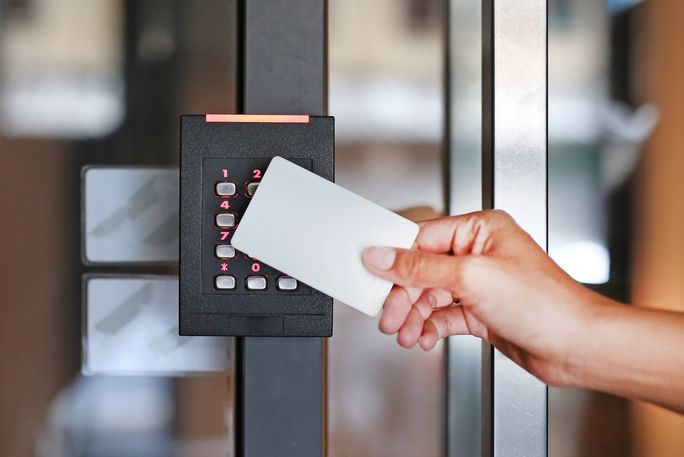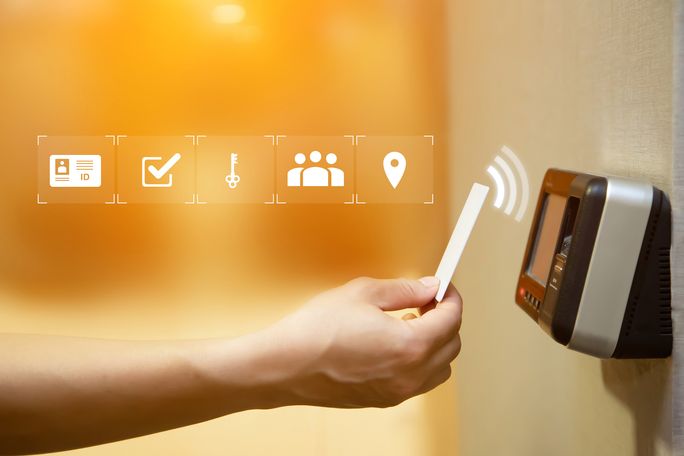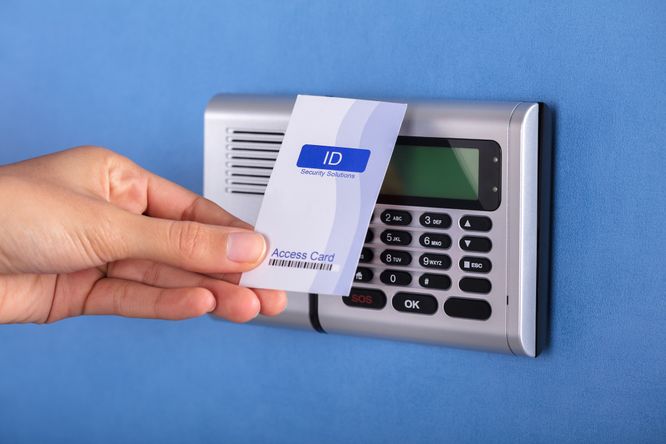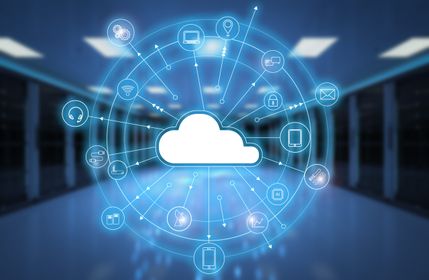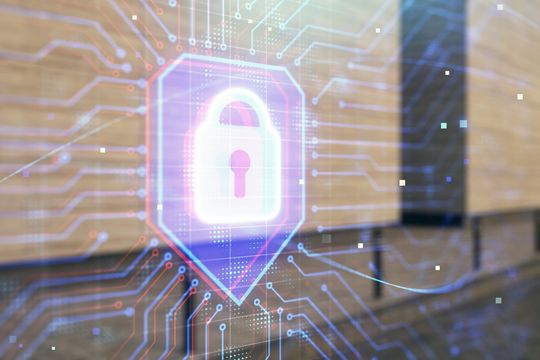Are you concerned about the security of your building? Do you want to enhance access control and monitoring? If you answered yes, a card access system may be the perfect solution for you. In this article, we will explore the benefits of card access systems and how they can improve security, reduce costs, and increase efficiency. Let’s dive right in!
Table of contents
- Components of a Card Access System
- Types of Card Access Systems
- Advantages of Implementing Card Access Systems
- Key Considerations for Choosing a Card Access System
- Real-World Applications of Card Access Systems
- Future Trends in Card Access Systems
Suggested Posts:
- Complete Guide to Key Card Entry Systems
- The Best Apartment Intercom Systems (2023)
- Unlocking the Benefits of Key Card Door Locks
- How to Install a Fob Door for Maximum Security
- Keyless Entry Systems for Apartments- Essential Tips for Buying
What is a Card Access System?
A card access system is an electronic security system that restricts access to a building or area through the use of keycards or key fobs only. These devices contain unique codes that are recognized by the system, allowing authorized individuals to gain access to designated areas. Card access systems are widely used in commercial, institutional, and residential settings to enhance security and improve building management.
Card access systems are becoming increasingly popular due to their convenience and enhanced security features. Unlike traditional lock and key systems, card access systems allow administrators to easily manage access levels and track user activity. This makes it easier to identify and address potential security breaches, and also allows for more efficient building management.
Components of a Card Access System
A typical card access system consists of several components, including card readers, access control panels, software, and cards or fobs. Card readers are the devices that scan the access cards or fobs and send the information to the access control panels. The access control panels are responsible for verifying the information and granting or denying access. The software enables administrators to manage the access control system, add or delete users, set access levels, and generate reports. The cards or fobs are distributed to authorized individuals and are used to gain entry into the building or areas.
Card readers and access control panels come in a variety of types and styles to suit different building requirements. Some card readers are designed for outdoor use and are weatherproof, while others are designed for indoor use only. Access control panels can be mounted in a central location or distributed throughout the building, depending on the size and layout of the building.
Types of Card Access Systems
There are several types of card access systems available in the market today. Some of the common types include standalone systems, networked systems, and cloud-based systems.
Standalone systems: are suitable for small offices or residential buildings with limited access control requirements. These systems are typically easy to install and use, and may not require any special software or hardware.
Networked systems: are ideal for larger buildings or institutions with multiple access points and users. These systems are connected to a central server or database, allowing administrators to manage access levels and user activity from a single location. Networked systems can also be integrated with other security systems, such as CCTV cameras and alarm systems, for enhanced security.
Cloud-based systems: are the latest trend in card access systems, offering remote access and management capabilities through the cloud. These systems are ideal for businesses with multiple locations or for administrators who need to manage access levels from remote locations. Cloud-based systems also offer enhanced security features, such as two-factor authentication and encryption, to protect user data.
Advantages of Implementing Card Access Systems
Card access systems have become increasingly popular in recent years due to their numerous benefits. In this article, we will explore some of the advantages of implementing card access systems in your building.
Enhanced Security
One of the primary benefits of card access systems is enhanced security. With a card access system, you can ensure that only authorized individuals can enter designated areas of your building. This is particularly important in areas with high-value assets, sensitive information, or confidential documents. By restricting access, you can reduce the risk of theft, vandalism, or unauthorized access.
Moreover, card access systems can help prevent security breaches that may occur due to lost or stolen keys. Unlike traditional keys, access through smart cards can be easily deactivated if lost or stolen, making it easier to maintain a secure environment.
Access Control and Monitoring
Another advantage of card access systems is access control and monitoring. With a card access system, you can set custom access levels for different users based on their roles and responsibilities. This ensures that only authorized users can enter specific areas or perform certain functions. Additionally, some card access control systems allow you to monitor access in real-time, providing you with insights into user behavior and patterns. You can generate reports and audit trails to track access attempts, denials, and violations.
Furthermore, card access systems can be integrated with other security systems such as CCTV cameras and alarms, providing a comprehensive security solution for your building.
Reduced Costs and Increased Efficiency
Card access systems can also help you reduce costs and increase efficiency. With a card access system, you can eliminate the need for traditional keys or locks, which can be expensive to replace or rekey. Additionally, card access systems can reduce the time and effort required for manual entry and exit monitoring, thereby improving overall building management.
Moreover, card access systems can be integrated with other building management systems such as HVAC and lighting, allowing for centralized control and automation.
Customizable Access Levels
Card access systems offer customizable access levels, which is especially important in large organizations or institutions with multiple departments or levels of access. By setting custom access levels, you can ensure that only authorized individuals can access specific areas or perform specific functions. This can help you maintain a secure and efficient building environment.
Furthermore, card access systems can be easily scaled to accommodate changes in your organization, making it a flexible and adaptable solution for your building security needs.
In conclusion, card access systems offer numerous benefits that can help you maintain a secure and efficient building environment. From enhanced security to customizable access levels, card access systems provide a comprehensive solution for your building security needs.
Key Considerations for Choosing a Card Access System
When it comes to building security, choosing the right card access system is essential. Not only does it provide an added layer of protection, but it also allows for easy management and monitoring of who enters and exits the building. Here are some key considerations to keep in mind when selecting a card access system.
Scalability and Flexibility
As your organization grows and changes, so too will your security needs. That’s why scalability and flexibility are important factors to consider when choosing a card access system. You want to select a system that can easily expand to accommodate new users, access levels, and locations. Look for a system that offers modular components, allowing you to add or remove features as needed.
Another important consideration is the ability to integrate with other security systems. For example, if you have multiple buildings, you’ll want a system that can be centrally managed and monitored. This will help ensure that security protocols are consistent across all locations.
Integration with Existing Systems
Speaking of integration, it’s important to select a key card access system that can seamlessly integrate with your existing building management software, security cameras, and alarm systems. This will provide a more comprehensive security solution and make it easier to manage and monitor your building security.
Additionally, consider the compatibility of the card access system with your existing IT infrastructure. If your organization is already using a particular type of technology, such as cloud-based systems, you’ll want to ensure that the card access system can integrate with it.
Ease of Use and Maintenance
When it comes to security systems, ease of use and maintenance are key factors to consider. You want a card access system that is user-friendly and easy to use, especially for non-technical staff. This will reduce the likelihood of errors and ensure that everyone is able to use the system effectively.
It’s also important to consider the maintenance requirements for the system. This includes things like software updates, battery replacements, and card/fob distribution. Look for a system that has a low maintenance requirement and is easy to troubleshoot in case of any issues.
By keeping these key considerations in mind, you can select a card access system that meets your organization’s security needs and provides peace of mind for everyone in the building.
Real-World Applications of Card Access Systems
Card access systems have become increasingly popular in various industries due to their ability to manage building access and ensure security. In addition to providing a secure environment, card access systems offer a range of benefits, including attendance tracking, emergency response, and staff management.
Office Buildings and Corporate Environments
Card access systems are commonly used in office buildings and corporate environments to manage building access and ensure security. With a card access system, you can limit access to certain areas and allow only authorized personnel to enter. This helps prevent theft, vandalism, and other security breaches. Additionally, card access systems can help with time-tracking and attendance management. By tracking when employees enter and leave the building, you can ensure that they are working the required hours and are not taking unauthorized breaks.
Another benefit of card access systems in corporate environments is that they can help with visitor management. With a card access system, you can issue temporary access cards to visitors and contractors, which can be programmed to expire after a set period of time. This ensures that visitors do not have access to sensitive areas of the building once their business is complete.
Educational Institutions
Educational institutions, such as schools and universities, can benefit from card access systems to ensure the safety and security of students and staff. With a card access system, you can limit unauthorized access to classrooms, labs, and administrative offices. This helps prevent theft, vandalism, and other security breaches. Additionally, card access systems can help with attendance tracking and emergency response. By tracking when students and staff enter and leave the building, you can ensure that everyone is accounted for in the event of an emergency.
Another benefit of card access systems in educational institutions is that they can help with library management. With a card access system, you can limit access to the library to authorized personnel and students, ensuring that books and other resources are not lost or damaged.
Healthcare Facilities
Healthcare facilities, including hospitals and clinics, can benefit from card access systems to protect patient confidentiality and regulate access to sensitive areas. With a card access system, you can limit access to patient rooms, medical records, and pharmaceutical supplies. This helps prevent theft, tampering, and other security breaches. Additionally, card access systems can help with staff management and tracking. By tracking when staff members enter and leave the building, you can ensure that they are working the required hours and are not taking unauthorized breaks.
Another benefit of card access systems in healthcare facilities is that they can help with inventory management. With a card access system, you can limit access to medical supplies and equipment, ensuring that they are not misused or stolen.
Government Buildings
Government buildings, such as courthouses and municipal offices, require strict security measures to protect sensitive information and maintain public safety. With a card access system, you can regulate entry and exit to designated areas and restrict access to authorized personnel. This helps prevent security breaches and ensures that only authorized personnel have access to sensitive information. Additionally, card access systems can help with tracking attendance and monitoring employee behavior. By tracking when employees enter and leave the building, you can ensure that they are working the required hours and are not taking unauthorized breaks.
Another benefit of card access systems in government buildings is that they can help with document management. With a card access system, you can limit access to sensitive documents and ensure that they are not lost or stolen.
Future Trends in Card Access Systems
The use of card access systems has become an increasingly popular method of security in recent years. These systems provide a secure and efficient way of controlling access to sensitive areas within organizations. However, as technology continues to evolve, so do the trends in card access systems. In this article, we will explore some of the future trends in card access systems.
Biometric Integration
One of the most significant future trends in card access systems is biometric integration. Biometric integration involves using a user’s unique biological characteristics to grant access to secure areas. This can include fingerprint, iris, or facial recognition. Biometric integration can enhance security and reduce the risk of card theft or replication. It also provides a more convenient and efficient way of granting access to users.
Biometric integration can also be used to monitor user behavior. For example, if a user attempts to gain access to a secure area but is not authorized, the system can automatically flag this behavior and alert security personnel. This can help prevent security breaches before they occur.
Mobile and Cloud-Based Solutions
Another future trend in card access systems is the use of mobile and cloud-based solutions. Mobile and cloud-based solutions are becoming increasingly popular in card access systems. Users can access the system remotely through their smartphones, enabling flexibility and convenience. Additionally, cloud-based solutions can reduce the cost of hardware and software maintenance for organizations.
Mobile and cloud-based solutions can also provide real-time data and analytics. This can help organizations make informed decisions about their security systems. For example, if there is a security breach, the system can send an alert to the user’s mobile device, enabling them to take immediate action.
Advanced Analytics and Reporting
Advanced analytics and reporting will also play a role in card access systems in the future. Organizations will be able to generate detailed reports and insights on security breaches, user behavior, and hardware performance. This can enable predictive maintenance and proactive security measures.
Advanced analytics and reporting can also help organizations identify areas of improvement in their security systems. For example, if there is a high rate of unauthorized access attempts in a particular area, the organization can take steps to improve security measures in that area.
In conclusion, the future of card access systems is exciting and full of possibilities. Biometric integration, mobile and cloud-based solutions, and advanced analytics and reporting are just a few of the trends that will shape the future of card access systems. As technology continues to evolve, we can expect to see even more innovative solutions in the field of security.
Conclusion
In conclusion, card access systems offer numerous benefits to organizations of all sizes. By providing enhanced security, access control, and monitoring capabilities, card access systems can improve building management and reduce costs. When choosing a card access system, consider factors such as scalability, integration, and ease of use. Stay ahead of the trends by keeping an eye on emerging technologies such as biometric integration, mobile solutions, and advanced analytics. With a reliable and efficient card access system in place, you can maintain a secure and efficient building environment.
Upgrade Your Building Security
Get in touch with a Swiftlane specialist for more information on the best access control and video intercom solution for your building.

